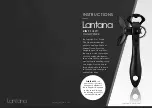
Following installation, the operator MUST be tested and
respond correctly to all controls as specified on the wiring
diagram. Keep personnel and equipment clear of the area
beneath the door when performing the tests. When testing the
3-button wall station, first observe that each button operates the
door in the direction indicated and that the STOP button
performs that function. With the door stopped at its full open
position, the OPEN button should be inoperative. This should
be verified and, likewise, the CLOSE button should be
inoperative with the door fully closed.
Certain operator control circuits use only a single button or a
two button control station and may be designed to function
differently than the more common three-button circuit
described above. Test the controls in accordance with the
description of operation as indicated on the wiring diagram and
as selected on pages 14, 15, and 16, Operating & Set-Up
Modes.
Observe the door when traveling in each direction for
smoothness of operation. Test the setting of the clutch by
restraining the door by hand. The clutch should slip. Re-check
the limit settings. The door should close tightly at the floor
without excessive impact. Likewise, it should fully clear the
door opening without the carrier striking the stops on the rail.
The AU-S series operators are equipped with a reversing edge
circuit and to conform with code, need to be connected to a
pneumatic or foam door edge or photoelectric device. To test an
edge for proper reversal, place an object beneath the leading
edge of the door. To test a photoelectric device for proper
reversal, start the door down and obstruct the beam. The door
TESTING
should instantly reverse when it comes into contact with the
object provided the height of the object exceeds the cut out point
built into the close limit switch (approx. four (4) inches).
If the operator is equipped with other means of control, such as
additional 3 button stations or radio controls, each of these should
be tested separately for proper operation.
Test the manual disconnect with the door in the fully closed
position. The door arm should freely fall away from the carrier
when the release chain is pulled. If it is difficult to release and the
door arm appears to be under compression, reset the CLOSE limit
slightly to reduce the travel of the carrier in the close direction.
ALWAYS DISCONNECT POWER TO
THE OPERATOR BEFORE SERVICING,
CONNECTING ACCESSORY DEVICES
OR MAKING ADJUSTMENTS.
WARNING
CAUTION
DO NOT STAND UNDER DOOR
TO TEST REVERSING EDGE
USE A CORRUGATED BOX
OR OTHER SIMILAR OBJECT
Normally, very little maintenance is required. A monthly visual
inspection must be made for loose or missing hardware and for
excessive slack in the V-Belt and drawbar chain. The clutch
must be tested periodically and adjustments made if necessary
(see page 18). The brake (where applicable) is adjusted at the
factory and will need periodic adjustment for wear. When
adjustment becomes necessary see
Figure 21
on page 16 for
the adjustment procedure.
Test the reversing edge circuit at least once a month by
permitting the door to contact an obstruction while closing. To
test a pneumatic or foam door edge for proper reversal, place an
object beneath the leading edge of the door. To test a
photoelectric device for proper reversal, start the door down
and obstruct the beam. The door should instantly reverse when
it comes into contact with the object provided the height of the
object exceeds the cut out point built into the close limit switch
(approx. four (4) inches).
Lubrication of the operator is not required. It is important, for
trouble free service from the operator, that the door be kept free
from binding, properly counter balanced and periodically
lubricated.
An annual inspection of the door by a qualified
overhead door professional is recommended.
Warning: Repairs and adjustments to the door and operator
should be performed only by someone qualified to service
commercial overhead doors and operators.
CAUTION
DO NOT STAND UNDER DOOR
TO TEST REVERSING EDGE
USE A CORRUGATED BOX
OR OTHER SIMILAR OBJECT
MAINTENANCE
OPERATION AND ADJUSTMENT INSTRUCTIONS
19






































